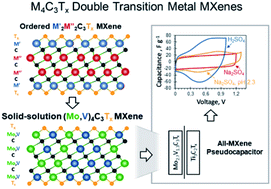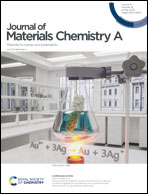Synthesis and electrochemical properties of 2D molybdenum vanadium carbides – solid solution MXenes†
Abstract
MXenes have demonstrated high performance as negative electrodes in supercapacitors with aqueous electrolytes due to their high redox capacitance. However, oxidation limits their use under positive potential, requiring asymmetric devices with positive electrodes made of other materials which are usually less capacitive compared to MXenes and therefore limit the device performances. Here, we report the synthesis of two-dimensional molybdenum vanadium carbides (MoxV4−xC3), previously unexplored double transition metal MXenes, by selective etching of aluminum from MoxV4−xAlC3 MAX phase precursors. Unlike the ordered double transition metal MXenes reported previously, MoxV4−xC3 exhibits a Mo–V solid solution in the transition metal layers. We have synthesized and characterized four different compositions of MoxV4−xC3 with x = 1, 1.5, 2, and 2.7. We showed that by changing the Mo : V ratio, the surface terminations (O : F ratio), and electrical and electrochemical properties of the resulting MXenes can be tuned. The Mo2.7V1.3C3 composition showed a remarkable volumetric capacitance (up to 860 F cm−3) and high electrical conductivity (830 S cm−1) at room temperature. Moreover, these solid solution MXenes have demonstrated the ability to operate in a wider range of positive potentials compared to other MXenes. Following this discovery, we coupled a Mo2.7V1.3C3 positive electrode with a well-studied Ti3C2 MXene negative electrode to create an all-MXene supercapacitor, as a proof of concept.

- This article is part of the themed collection: Journal of Materials Chemistry A HOT Papers


 Please wait while we load your content...
Please wait while we load your content...